Ferrari F80
The F80 is Ferrari's new supercar, a car destined to join iconic models from the 1984 GTO to the 2016 LaFerrari Aperta.
 Photos by Ferrari S.p.A.
Photos by Ferrari S.p.A.
Ferrari unveiled the F80 and wrote a new chapter on the history of legendary supercars bearing the Prancing Horse badge. The F80 will be produced in a limited run of just 799 examples and joins the pantheon of icons such as the GTO, F40, and LaFerrari by showcasing the best that the Maranello-based marque has achieved in terms of technology and performance.
Since 1984, Ferrari has periodically released a new supercar representing the pinnacle of cutting-edge technology and innovation of its era and is destined to enshrined in popular culture. Intended for the brand's most discerning clients, these cars immediately became legends in their own lifetime, making an indelible mark not only on Ferrari's history but also on the automobile itself.
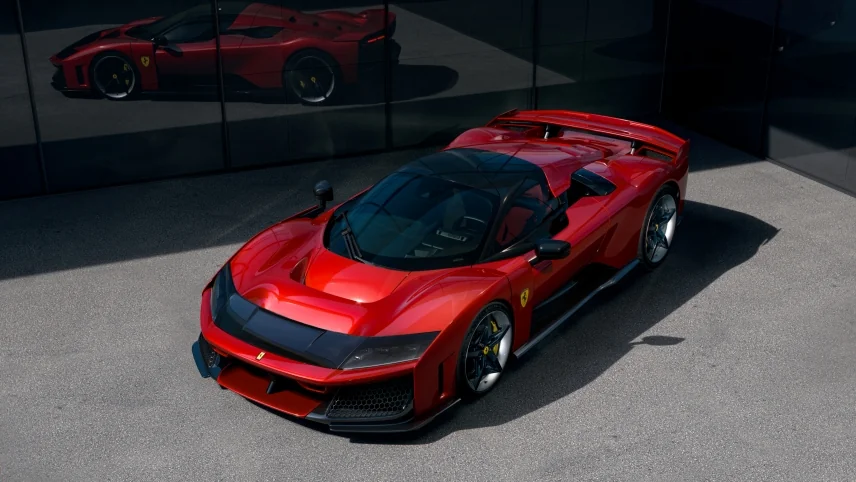
The latest addition to this family, the F80, is tasked with embodying the ultimate in engineering for an internal combustion engine vehicle. It employs all the most advanced technological solutions, including the latest-generation hybrid technology for the powertrain, to achieve unparalleled levels of power and torque. Every aspect of the architecture is conceived to maximize performance, from the carbon-fiber chassis and extreme aerodynamic solutions far beyond anything seen before in a road-legal car to the new active suspension optimized to let the driver wring every ounce of performance from the car on the track.
Unlike anything else in the current supercar world, the F80 combines all these attributes with uncompromising levels of usability on the road, where it can be driven easily. This ability shaped every choice made in terms of technology and architecture to achieve the goal, which at first sight seems impossible: creating a track-oriented supercar that's just as driveable as a production-range model.
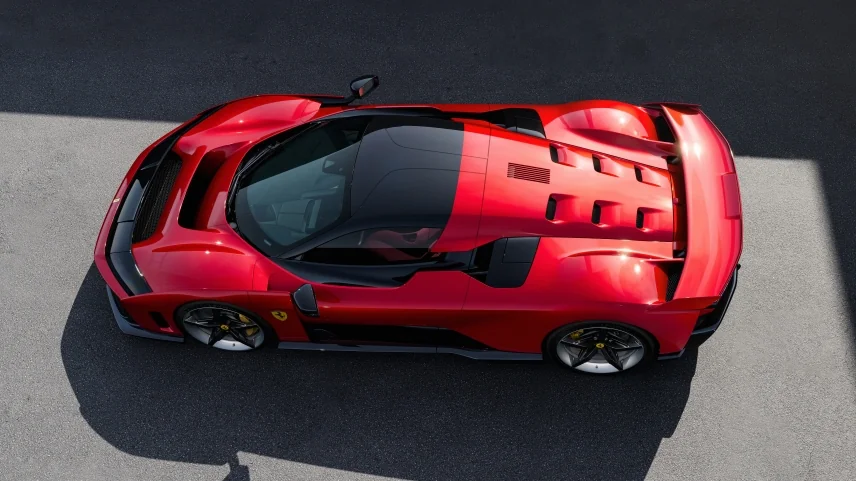
All this means that the driver will spend even more time in the car and can truly get to know and revel in its performance and the thrilling driving experience it offers. The architecture of the F80 is so extreme that the layout chosen results in a narrower cabin with a driver-centric layout, which nonetheless still offers excellent space and comfort for a passenger. This choice had crucial benefits in terms of minimizing drag and weight.
The cockpit area, therefore, has a distinct single-seater feel, even though the car is homologated for two occupants, resulting in an architecture that we could call “1+.” The primary reason for this choice was to minimize width, which benefits aerodynamics (with less drag) and weight savings. This concept is completely in keeping with the motorsport world from which this car draws inspiration and inherits technological solutions.
As has always been the case with the Ferrari supercars preceding the F80, the powertrain is based on the finest expression of technology in motorsport. A turbo V8 powered the GTO and F40 because Formula 1 cars used turbocharged engines in the 1980s. Today, in both Formula 1 and the World Endurance Championship (WEC), powertrains consist of turbo V6 ICE engines mated with an 800 V hybrid system. It was only natural then that this architecture - the same architecture used by the 499P, which has taken two consecutive victories at the 24 Hours of Le Mans - would be transferred into the new F80.
Here though the powertrain is further complemented by the introduction, for the first time ever on a Ferrari, of electric turbo technology (e-turbo), which, with an electric motor installed between the turbine and compressor of each turbo, allows for an extraordinary specific power output and instantaneous response from low down in the rev range.
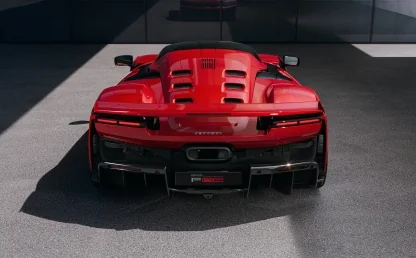
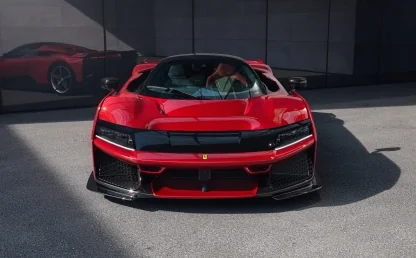
Aerodynamics plays a key role in the F80, with solutions such as the active rear wing, rear diffuser, flat underbody, front triplane wing, and S-Duct working in concert to generate 1000 kg of downforce at 250 km/h. This result is further enhanced thanks to the active suspension, which contributes directly to generating ground effects. Performance is boosted by the electric front axle, which brings four-wheel drive capability to make even more effective use of the torque and power on tap, and the new brakes with motorsports-derived CCM-R Plus technology.
As with all the supercars preceding it, the F80 marks the start of a new design era for Ferrari, with a more tense, extreme design language accentuating its race-bred soul. There are clear references to cues borrowed from aerospace, which underscore the cutting-edge technology and elegant engineering of each technical solution. But there are also nods to its hallowed progenitors, which clearly declare the F80's illustrious lineage.
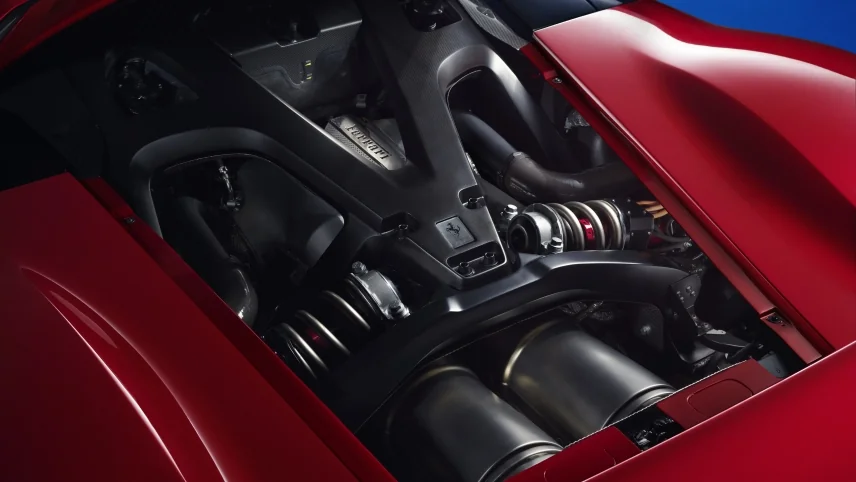
Powertrain - Internal Combustion Engine
The three-liter 120° V6 F163CF of the F80 is the ultimate expression of the Ferrari six-cylinder engine: this unit produces an astonishing peak power of 900 hp, making it the Ferrari engine with the highest specific power of all time (300 cv/l), to which the electric front axle (e-4WD) and rear motor (MGU-K) of the hybrid system add another 300 cv.
The link with motorsports, and endurance racing in particular, is strong: the architecture of this engine and many of its components are closely derived from the powerplant of the 499P, which won the last two editions of the 24 Hours of Le Mans. Commonalities with the car competing in the World Endurance Championship (WEC) include the architecture, crankcase, layout, and drive chains of the timing system, oil pump recovery circuit, bearings, injectors, and GDI pumps.
Naturally, there is also technology carried over from Formula 1, from which the F80 inherits both the concept of the MGU-K (with the development of an industrially manufacturable electric motor similar to the unit used in Ferrari F1 cars) and the MGU-Hs (which generate power from the excess kinetic energy from the rotation of the turbines created by the heat energy from the exhaust gases) with a bespoke e-turbo application.
For maximum performance in all possible conditions, every aspect of the calibration of the engine has been taken to the extreme, focusing in particular on the ignition and injection timing, the number of injection events per stroke, and the management of the variable-phase valve timing. The F80 is equipped with the first Ferrari road car engine to benefit from a new approach for statistical knock control, which lets the engine operate even closer to the knock limit, allowing the use of higher combustion chamber pressures than ever (+20% compared with the 296 GTB) to unleash even more of the engine's potential.
Another crucial aspect has been the work dedicated to the dynamic calibration of the torque curve in every gear, an all-time first for a Ferrari road car. This part of the project focused on real road-driving conditions and the management of the e-turbo system because knock and compressor surge limits vary depending on whether they are measured in dynamic or stationary conditions. As a result of this research, a dedicated calibration was developed for each gear, allowing the engine to attain levels of responsiveness comparable to a naturally aspirated engine in all operating conditions.
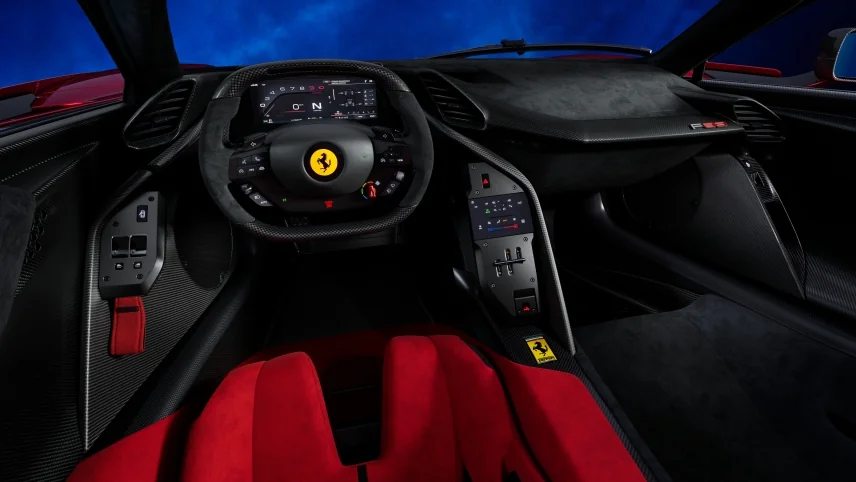
The e-turbos, with an electric motor installed axially between the turbine and the compressor housing, let the engineers optimize the fluid dynamics of the engine for maximum power at mid to high engine speeds without the usual compromise this entails in terms of turbo lag at low engine speeds. Bringing electric power into the equation makes it possible to define e-turbo management strategies that negate turbo lag and ensure lightning-quick response times.
The 350 bar injectors of the GDI system are situated at the centre of the combustion chamber for optimal fuel/air mixing and, together with the multiple injection strategies adopted, ensure efficiency for outstanding performance with lower emissions. The intake and exhaust cam profiles have been revised to optimize fluid dynamic efficiency and increase maximum engine speed to 9000 rpm, with a dynamic limiter at 9200 rpm.
Both the intake and exhaust runners are polished for better performance; the intake runners have been shortened to reduce resistance and cool the air/fuel mixture through fluid dynamic detuning and are specifically designed to increase turbulence in the combustion chamber. The three-brick (matrices) exhaust line complies with current emissions standards (Euro 6E-bis) but already takes future evolutions in emissions regulations on a global level into account.
The Inconel© exhaust manifolds are designed to minimize pressure losses and are tuned to emphasize the distinctive sound of a Ferrari V6. The steel crankshaft is machined from a die-cast element and features hot-forged crankpins with an offset angle of 120°. The 1-6-3-4-2-5 firing order lends the F80 a typical Ferrari timbre. To reduce weight, the crankshaft webs and counterweights have been lightened.
The connecting rods and pistons have also been revised: the titanium connecting rods feature a toothed interface at the mating surface between the shank and the big end cap to ensure perfect alignment between the two parts and absolute assembly precision with the bearings. The aluminum pistons have been optimized to reduce weight and withstand the combustion chamber's higher pressure and thermal loads due to the incredibly high torque and power. Specifically, high-strength DLC (diamond-like carbon) coated steel has been used for the piston pin. Additionally, a dedicated oil passage hole has been added to the zone between the piston pin and the connecting rod to improve lubrication.
To lower the car's center of gravity, the engine has been installed as close as physically possible to the flat undertray. As a result, none of the components situated at the bottom of the sump are more than 100 mm below the crankshaft's centreline. It was also decided to tilt the engine transmission unit by 1.3° in the Z axis, raising the gearbox so that it does not compromise the efficacy of the aerodynamic undertray.
To lighten the engine, the cylinder block, crankcase, timing cover, and other components have been revised, while titanium screws have also been adopted. As a result of these measures, the engine weighs no more than the V6 of the 296 GTB despite a power increase of 237 hp.
The new smaller-diameter flywheel, conceived and designed from scratch for this application, permitted the lowered installation position of the engine transmission unit. This innovative solution was made possible by the use of two sets of springs, which also contributed to reducing the overall stiffness of the system and filtering vibrations transferred to the transmission more effectively. The damper was also developed specifically for this application to attenuate the higher torsional vibration forces in the driveline and dissipate the higher thermal loads due to the increased performance.
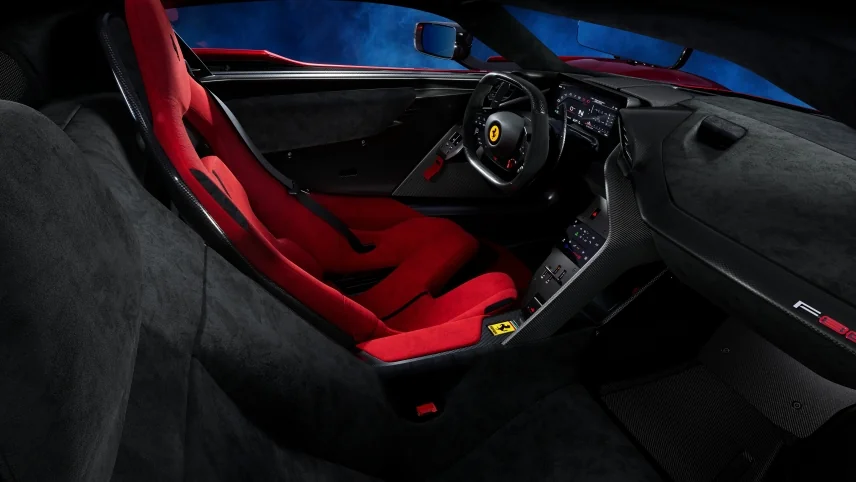
Powertrain - Hybrid Powertrain
The electric motors used for the F80 are the first units developed, tested, and manufactured entirely by Ferrari at Maranello, all with the specific goal of maximizing performance and reducing weight. Their design (with two on the front axle and one at the rear of the car) draws directly from Ferrari's experience in racing; specifically, the stator and rotor in a Halbach array configuration (which uses a special layout of the magnets to maximize magnetic field strength) and magnet sleeve in carbon fiber are all solutions derived from the design of the MGU-K unit used in Formula 1.
The rotor adopts Halbach array technology to maximize magnetic flux density and minimize weight and inertia. The carbon fiber magnet sleeve, on the other hand, has been used to raise the maximum motor speed to 30,000 rpm. The concentrated winding stator reduces the weight of copper used for the end windings, while the Litz wire minimizes high-frequency losses. The Litz consists of multiple insulated strands instead of a single wire, reducing the ‘skin effect' and allowing the current to flow uniformly through the entire cross-section of the wire to minimize losses. The resin coating for all the active parts of the stator improves heat dissipation.
A DC/DC converter transforms DC current at one voltage to DC current at a different voltage. This innovative technology makes it possible to use a single component to handle three different voltages simultaneously: 800 V, 48 V and 12 V.
Using the direct current produced by the high-voltage battery at 800 V, the Ferrari converter generates direct current at 48 V to power the active suspension and e-turbo systems and 12 V direct current to power the electronic control units and all other electric ancillaries on the vehicle. Innovative resonant technology allows this component to convert current with no latency with a conversion efficiency in excess of 98% so that it behaves to all intents and purposes as an accumulator. This component eliminated the need for a 48 V battery, saving weight and simplifying the layout of the electrical system.
Also developed and manufactured entirely in-house by Ferrari, the front axle includes two electric motors, an inverter, and an integrated cooling system. This component makes it possible to use torque vectoring for the front axle. Integrating different functions in a single component and the new mechanical layout have offered a weight saving of around 14 kg over previous applications, and the entire component weighs just 61.5 kg. Optimizing mechanical efficiency was a primary goal: low-viscosity oil (Shell E6+) and a dry sump active lubrication system with an oil tank integrated directly into the axle reduced mechanical power losses by 20%. The use of high coverage ratio (HCR) gears contributed to reducing noise emissions by 10 dB.
The direct current received from the high-voltage battery is transformed into the alternating current necessary to power the electric motor by the inverter. The inverter integrated into the front axle is bidirectional, meaning that it also transforms the alternating current produced by the axle under regenerative braking into a direct current for recharging the battery. The inverter used to convert power and control the two front motors can deliver a total of 210 kW of power to the axle. On the F80, the inverter is integrated directly into the axle and weighs just 9 kg, contributing to the lower mass of this component compared to its counterpart on the SF90 Stradale.
Another inverter is used for the rear electric motor (MGU-K). This performs three functions: starting the internal combustion engine, recovering energy to recharge the high-voltage battery, and supplementing the torque of the engine in certain dynamic conditions. It can generate up to 70 kW in regeneration mode and assist the internal combustion engine with up to 60 kW of power. Integrated into both of these inverters is the Ferrari Power Pack (FPP) system, a power module with all the elements necessary for power conversion combined in the most compact unit possible. This unit consists of six modules in silicon carbide (SiC), gate driver boards and a dedicated cooling system.
The core of the energy accumulation system - the high-voltage battery - is conceived for very high power density. The innovative design of the battery is based on three principles: lithium-cell chemistry derived from Formula 1, extensive use of carbon fiber for the construction of the monocoque casing, and a patented design and assembly method (cell-to-pack) that minimizes the weight and volume of the unit. Situated low down in the engine bay, the pack contributes to even better dynamic vehicle behavior by lowering the car's center of gravity. All electrical and hydraulic circuit connectors are built into the component to reduce cable and hose length, while the pack is configured with 204 cells connected in series and subdivided equally into three modules for a total energy capacity of 2.3 kWh and a maximum power output of 242 kW.
Last but not least, to improve integration between the electric and electronic internal components, Ferrari developed the CSC (Cell Sensing Circuit) wireless sensor suite, which monitors cell voltage with spring contacts and measures cell temperatures with infrared sensors.
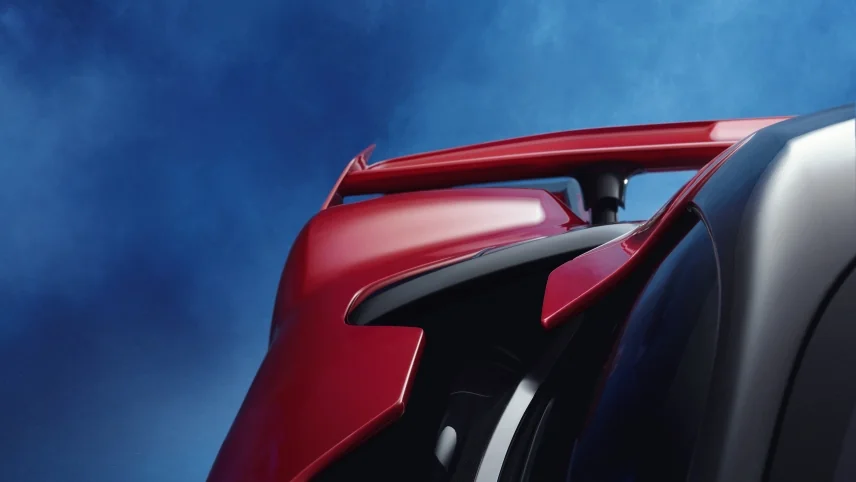
Aerodynamics
The F80 pushes aerodynamic performance to levels never seen before on a Ferrari road car, as testified by the 1000 kg of downforce produced at 250 km/h. This astonishing achievement was made possible by perfect symbiosis between all the internal Ferrari departments working on the definition of the car's architecture; for each department, the perfect balance between downforce and top speed was the basis for every design choice, giving shape to a suite of extreme solutions befitting a true supercar.
The front end of the F80, which develops 460 kg of total downforce at 250 km/h, was inspired by the aerodynamic concepts employed in Formula 1 and the World Endurance Championship (WEC), innovatively reinterpreted for this application to become cornerstones of the entire design. On the one hand, the recumbent racing driving position allowed for a chassis with a high center keel, while on the other, the cooling system layout freed up the entire central portion of the vehicle, maximizing the space usable for other functions.
The body-colored central volume of the nose acts as the generously sized main plane of the front wing. Inside the S-Duct are two flaps following the main profile to complete the triplane wing configuration with curvatures and blower slots clearly inspired by the 499P. Crucial for the aerodynamic efficacy of the front of the vehicle is the way the triplane works perfectly with the S-Duct and the high central keel, minimizing blockage of the airflow towards the wing and maximizing performance.
As a result, the airflow from the underbody and bumper undergoes violent vertical expansion and is redirected within the duct towards the front bonnet, generating a potent upwash, which translates into a powerful low-pressure zone under the underbody. This accounts for 150 of the 460 kg of the maximum downforce generated at the front of the car, which, however, is very sensitive to changes in ground clearance. The aerodynamic balance of the car is, therefore, ensured by the active suspension, which controls the attitude of the vehicle in real time and adjusts the distance between the underbody and the road in response to driving conditions.
The volume freed up under the feet of the driver also made room for three pairs of bargeboards. These devices generate powerful, concentrated vortices that introduce a velocity component to the airflow field in the outwash direction. In addition to improving the underbody's suction, the outwash also reduces blockage and improves the performance of the front triplane. The bargeboards also help mitigate the detrimental effects of the wake of the front wheel by confining it and keeping it away from the underbody, preventing contamination of the airflow directed to the rear of the car.
The aerodynamic performance of the rear zone of the car, which generates the remaining 590 kg of downforce at 250 km/h, is a result of the combined action of the rear wing-diffuser system. The efficiency of this system is highly dependent on the quantity of downforce produced by the underbody, as this has very little impact on drag.
To take the performance of the diffuser of the F80 to extreme levels, the expansion volume of the diffuser itself has been maximized by inclining the engine-gearbox unit by 1.3° in the Z axis and by the configuration of the rear chassis and suspension components. The starting point of the upward curvature of the diffuser has been brought forward, resulting in a diffuser measuring a record-breaking 1800 mm in length, which generates a huge low-pressure zone underneath the vehicle, which in turn draws a massive flow of air into the underbody area.
The geometry of the chassis, with narrow, curved sills, contributes to creating an aerodynamic seal effect around the underbody by forming a duct that captures the flow adhering to the flank and blows air into the interior of the rear wheel arch housing under the lower suspension arm. The interaction between this airflow and the outer strake of the diffuser interferes with the vortices generated in the wheel-road contact zone, preventing air from entering the diffuser too far forward. These solutions work in such perfect harmony that the downforce generated by the diffuser alone is 285 kg or more than 50% of the total downforce on the rear axle.
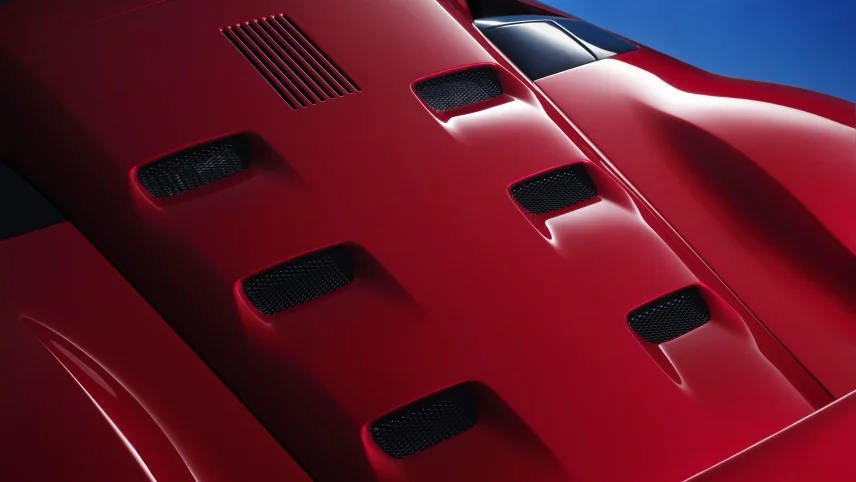
The active wing is the most visually distinctive aero feature of the F80, which completes the entire aerodynamic concept of the vehicle. The actuator system of the rear wing adjusts not only its height but also controls the angle of attack continuously and dynamically for precisely modulable downforce and drag. In the High Downforce (HD) configuration, which is used during braking, turn-in, and cornering, the wing assumes an angle of 11° relative to the direction of the airflow to generate over 180 kg of downforce at 250 km/h.
At the extreme opposite of its range of rotation, the wing is in a Low-Drag (LD) configuration, with the leading edge pitched upwards. Drag is much lower in this configuration, not only because of the reduction in lift but also due to the tractive effect generated by the residual low-pressure zone impinging on the underside of the wing itself.
The rear wing is the keystone of the entire adaptive aero system, allowing the F80 to adapt to any possible dynamic conditions, which are monitored and evaluated in real-time by the vehicle control systems. In response to the driver's requests regarding acceleration, speed, and steering angle, the system determines the optimal blend of downforce, aerodynamic balance, and drag and tells the active suspension and active aero systems to implement the ideal attitude accordingly. In the case of the aero system, this means controlling the angle of attack of the rear wing and the activation state of the Active Reverse Gurney flap under the front triplane.
With its two different configurations, the flap also allows control over downforce and drag at the front of the car: the closed position generates maximum downforce, while in the open position, the device is at right angles to the airflow and, similarly to how DRS systems work in Formula 1, stalls the underbody to reduce drag and let the car reach a higher top speed.
Find more Cars
The New Audi S8
The new Audi S8 uses specific design elements to express the sporty eleganc...
The Audi e-tron GT
With the e-tron GT, Audi is demonstrating how fascinating electric mobility...
McLaren 650S GT3
McLaren Automotive announced that the McLaren 650S GT3 is to star at the 20...
The all-new Bentley Continental GT
Designed, engineered, and handcrafted in Britain, the new third-generation ...
The Egoista on Permanent Display at Lamborghini Mu...
The prestigious collection in the Lamborghini Museum is now the home of ano...
The Black Bess Bugatti Vitesse
With its fifth model in the six-part Les Légendes de Bugatti (Bugatti Legen...



















